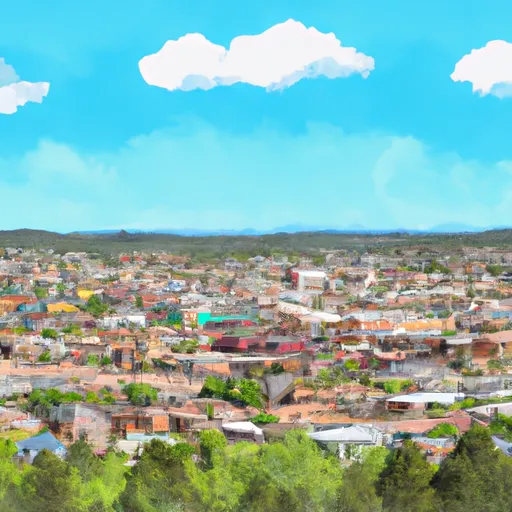-
 Snoflo Premium
Snoflo Premium
Get unlimited access to all our content
With no Ad interruptions! - Start Your Free Trial Login with existing account
Show-Low
Eden Index
Climate
9.2
•
Recreation
6.5
•
Community
2.0
•
Safeguard
6.4/10

Show Low is a city located in the White Mountains of Arizona. It experiences a semi-arid climate, characterized by hot summers and cold winters. Summers are warm with temperatures averaging in the mid-80s °F, while winters can be chilly with temperatures ranging from below freezing to the mid-40s °F. Show Low receives around 18 inches of annual precipitation, the majority of which falls during the summer monsoon season.
Hydrology constituents in Show Low are diverse, with several lakes and reservoirs in the surrounding area. The city sits near Show Low Creek and Fool Hollow Lake, offering opportunities for fishing, boating, and other water sports. The region is also known for its beautiful forests, with the Apache-Sitgreaves National Forest nearby. Outdoor enthusiasts can enjoy activities such as hiking, camping, mountain biking, and wildlife watching.
Overall, Show Low provides a pleasant climate with distinct seasons and ample outdoor recreation opportunities. Its picturesque landscapes and diverse hydrology make it an attractive destination for those seeking both natural beauty and adventure.
What is the Eden Index?
The Snoflo Eden Index serves as a comprehensive rating system for regions, evaluating their desirability through a holistic assessment of climate health, outdoor recreation opportunities, and natural disaster risk, acknowledging the profound impact of these factors on livability and well-being.
Climate Health Indicator (CHI): 9.2
Show-Low receives approximately
415mm of rain per year,
with humidity levels near 50%
and air temperatures averaging around
12°C.
Show-Low has a plant hardyness factor of
7, meaning
plants and agriculture in this region tend to thrive during the non-winter months.
By considering the ideal temperature range, reliable water supplies, clean air, and stable seasonal rain or snowpacks, the Climate Health Indicator (CHI) underscores the significance of a healthy climate as the foundation for quality living.
A healthy climate is paramount for ensuring a high quality of life and livability in a region, fostering both physical well-being and environmental harmony. This can be characterized by ideal temperatures, reliable access to water supplies, clean air, and consistent seasonal rain or snowpacks.
Weather Forecast
Streamflow Conditions
Little Colorado
Area Rivers
Little Colorado
Snowpack Depths
Little Colorado
Reservoir Storage Capacity
Little Colorado
Groundwater Levels
Recreational Opportunity Index (ROI): 6.5
The Recreational Opportunity Index (ROI) recognizes the value of outdoor recreational options, such as parks, hiking trails, camping sites, and fishing spots, while acknowledging that climate plays a pivotal role in ensuring the comfort and consistency of these experiences.
Access to outdoor recreational opportunities, encompassing activities such as parks, hiking, camping, and fishing, is crucial for overall well-being, and the climate plays a pivotal role in enabling and enhancing these experiences, ensuring that individuals can engage in nature-based activities comfortably and consistently.
Camping Areas
| Campground | Campsites | Reservations | Toilets | Showers | Elevation |
|---|---|---|---|---|---|
| Show Low Lake | 71 | 6,580 ft | |||
| Petrified Forest Dispersed | 10 | 5,467 ft | |||
| Lakeside | 91 | 6,723 ft | |||
| Lower Log | 100 | 6,153 ft | |||
| Scott Reservoir | 15 | 6,722 ft | |||
| Fool Hollow State Rec Area | 123 | 6,302 ft |
Nearby Fishing
Nearby Ski Areas
Catastrophe Safeguard Index (CSI):
The Catastrophe Safeguard Index (CSI) recognizes that natural disaster risk, encompassing floods, fires, hurricanes, and tornadoes, can drastically affect safety and the overall appeal of an area.
The level of natural disaster risk in a region significantly affects safety and the overall livability, with climate change amplifying these risks by potentially increasing the frequency and intensity of events like floods, fires, hurricanes, and tornadoes, thereby posing substantial challenges to community resilience and well-being.
Community Resilience Indicator (CRI): 2.0
The Community Resilience Indicator (CRI) recognizes that education, healthcare, and socioeconomics are crucial to the well-being of a region. The CRI acknowledges the profound impact of these elements on residents' overall quality of life. By evaluating educational resources, healthcare accessibility, and economic inclusivity, the index captures the essential aspects that contribute to a thriving community, fostering resident satisfaction, equity, and social cohesion.

